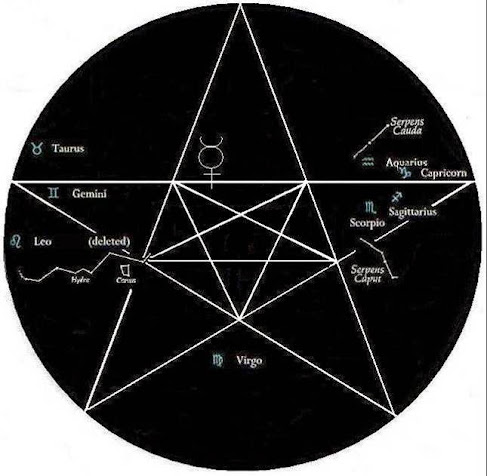The Sacred and Profane Love's entire formal structure is based upon the circle (which is inclusive of the pentacle) and strict cosmographic, metaphoric & iconological references. The Geometry: Venus and the Pentagram post has been isolated into this brief pictorial abstract:
 |
| Link here to Geometry: Venus and the Pentagram |
~
The History and Collaboration post has been recently edited & re-published. This post argues for recognition of Giorgione's auteurship in the S&P Love citing the late Wendy Sharman Sheard who saw Giorgione's hand in the Orpheus from around the period of the Fondaco dei Tedschi murals. Equally, there is an argument for Giorgione's influence in the collaboration known as the Sacred and Profane Love.
Link here to History and Collaboration.
~
Links to this sites most popular posts are listed below:
(Two posts have been removed and may be re-posted in the coming months. As I have found my original insights online without acknowledgement of the source of the argument (this blog)
I am reluctant to leave certain works in progress here until this gets sorted.)
~
(Two posts have been removed and may be re-posted in the coming months. As I have found my original insights online without acknowledgement of the source of the argument (this blog)
I am reluctant to leave certain works in progress here until this gets sorted.)
~
The Birth of Venus:
New Analysis Raises the Outstanding Iconographical
The Coronation of Venus/Aphrodite. [2.]
(The true meaning behind Botticelli's Birth of Venus)
~
The Sacred and Profane Love:
'The purpose of writing a visual analysis is to train the eye to see precisely, so that the mind may more accurately perceive...'.
~
Geometry: Venus and the Pentagram (link)
The formative development of the Sacred and Profane Love's basic geometry.
~
The Zodiacal Metaphors (link)
Perhaps still the most important post on this site: The Zodiacal Metaphors reveal anti-clockwise sequential references to specific zodiacal houses hidden within the painting and which form an allegorical language designed to deliberately coincide with the paintings geometric arrangements.
~
Discusses the classical and archetypal identities of the three figures at the sarcophagus/fountain, as well as the fountain itself - the original visual source, the geometric confirmation, and philosophical raison d'etre.
~
Meaning of the Fondaco dei Tedeschi murals (a digression)(link)
The intention of this post was to connect the child at the Fountain/Sarcophagus of the Sacred and Profane Love to the child with the 'wand' supposedly 'tapping apples' (J. Anderson. Giorgione - the Painter of 'Poetic Brevity'. New York : Flammarion, c.1997) that was painted on the walls of the German trade headquarters in Venice by Giorgione. This post argues that in both the Sacred and Profane Love and the Fondaco dei Tedeschi murals the child presented as a winged babe intends to represent the god Mercury, and as both instances conceive Mercury in this unique manner, it shall be argued that these portrayals can be traced to the oeuvre of Giorgione. But this connection can only be realised by deciphering the general meaning of the Fondaco murals and then comparing that finding with the child of the Sacred and Profane Love. This article finds that Giorgione is most likely responsible for this highly individual iconological presentation in both paintings.
~
Paul Doughton ©1997 - 2020.








